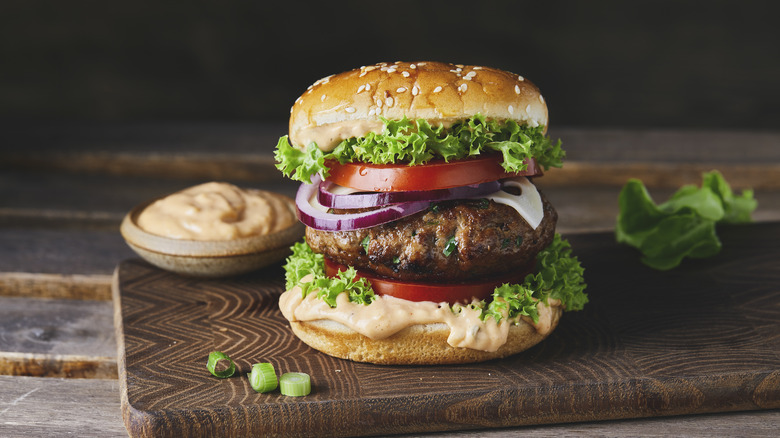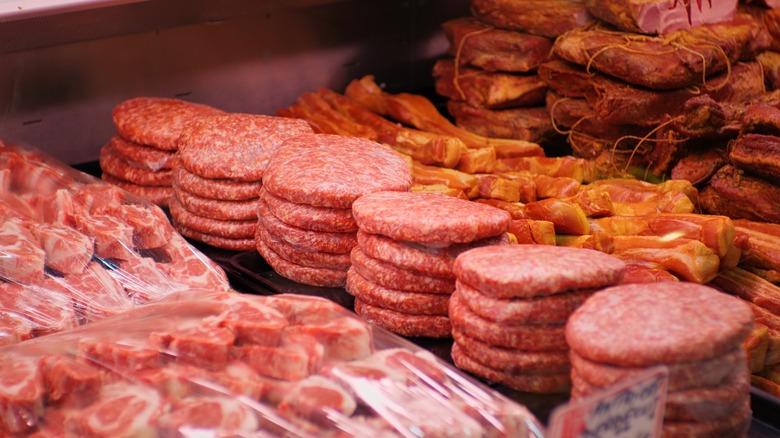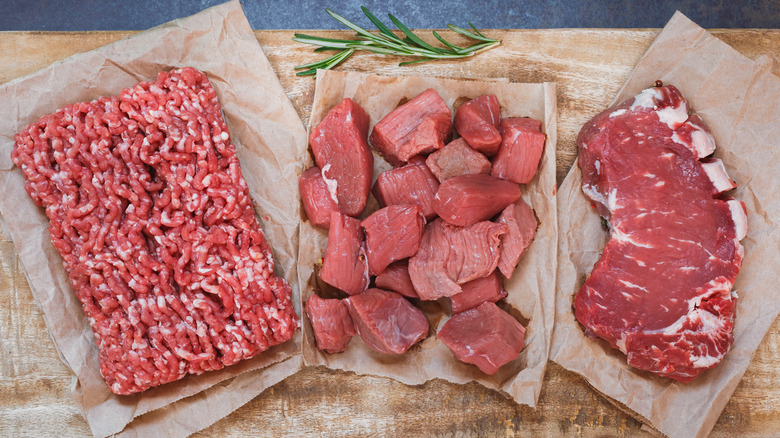Grass-Fed Beef Vs Grain-Fed: What Makes The Better Burger?
Burgers are a fundamental food, an American classic that's beloved by many — so if you've got a backyard barbecue, a casual picnic, or any kind of grill session planned, your recipe better be flawless. The last thing you want is to bite into a burger that's dry or flavorless and find that your time spent sweating in front of the grill was all for naught. Of course, the seasoning you choose and what you mix into your beef patties is important for the best burger recipe, but that's not where the discussion is focused today. Today, the focus is your burger's genesis, its foundation: When you're in the grocery store, should you be grabbing the grass-fed or the grain-fed beef?
Simply put, grass-fed beef is the designation for beef from cows that grazed almost only on grass and were not fed grain. Generally speaking, all cows graze on grass initially, but grain-fed beef comes from cows that eventually transitioned to a grain diet (usually corn and soy). Grass-fed beef can be more expensive than grain-fed because a grass diet means that the cows will take longer to reach the correct processing weight and involves a more costly process for the farmer.
When it comes to your burger recipe, much of your decision will rely on your personal preference for the meat's flavor and texture. As long as you search for quality meat with good fat content, though, grass-fed beef will typically lead to better burgers with a delicious taste.
Talking about the taste and texture
The flavors of grass-fed and grain-fed beef can be divisive (as flavor often is), so the taste question for your burgers may well come down to your own palate. Grain-fed beef tends to have a sweet, rich taste while grass-fed beef has a stronger, meatier, and more mineral quality. The gamier, beefier taste of grass-fed, though, suits a burger well and is one of the reasons grass-fed beef is generally better.
For the most flavorful beef, marbling is key. Marbling refers to the pattern of intramuscular fat in the meat rather than the fat between the muscles, which is generally cut off before cooking. The intramuscular fat, appearing as white or yellowish patches in a marble-like pattern, contributes to the meat's rich taste and tender texture. This type of fat leads to juiciness during cooking, as the fat melts and keeps the meat tender. Since grass-fed beef is leaner than grain-fed, it generally has less of this fat present, so you'll have to seek out high-quality cuts and pay attention to the marbling before you buy. You can also add in extra fat from a different cut of meat before you grind to help create a more tender texture for grass-fed burgers.
Looking at the health benefits
Although burgers are often a delightful indulgence and health might not be where your head is at during the backyard cookout, grass-fed beef does have some nutritional benefits too. Because grass-fed beef is leaner, it typically has fewer calories than grain-fed beef and has been shown to have higher levels of omega-3 fatty acids — as much as five times the amount of grain-fed beef. It also has around twice the amount of conjugated linoleic acid, which according to a study published in the scientific journal "Nutrients," can help with the promotion of weight loss. Beef in general has high levels of protein as well as iron, zinc, and vitamins B3, B6, and B12, but grass-fed beef has slightly higher levels of vitamins A and E than grain-fed beef.
If a generally healthier burger is appealing and so is a meatier, beefier flavor for your patty, then grass-fed is the way to go. You won't want to skimp on the quality of your meat either way and you may want to add in a little fat for the sake of texture if the marbling isn't quite there, but the effort will result in a juicy, delicious burger.


